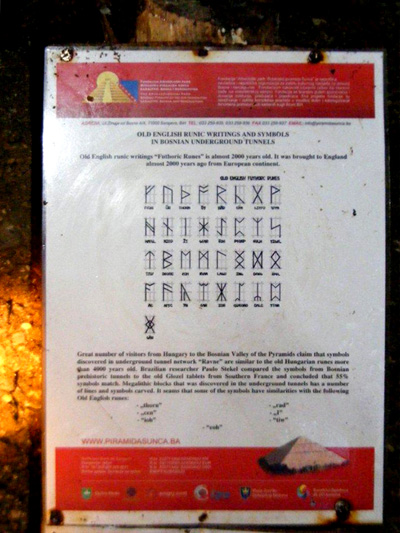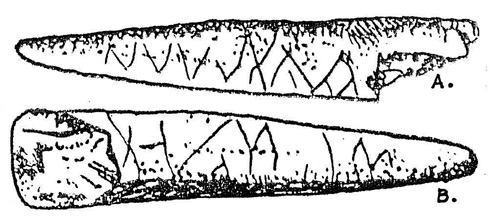|
|
|
Old english runic writings and symbols in Bosnian Ravne tunnel?
|
|
|
Klára Friedrich: Old english runic writings and symbols in Bosnian Ravne tunnel? |
Ever since Dr. Semir Osmanagic
pyramid researcher, excavating an archaeological site since 2005 in Bosnia,
great many Hungarians are visiting the Valley of Pyramids on a regular basis.
Géza Radics, a history researcher, visited the site in 2011. He notified me
in a letter, that in the Ravne tunnel leading to the Sun Pyramid, there is a
notice hanging on the wall, with the above title, which reads as follows:
"Old English runic writings 'Futhoric Runes,' are almost 2000 years old. It was brought to England almost 2000 years ago from the European continent." Then it goes on to say that "some of the symbols have similarities with the Old English runas".
Géza Radics attached a picture of this notice to his letter, which was photographed by Miklós Szondi. Exhibit 1.

Exhibit 1.
On the Exhibit 1. German runas are seen. Radics also informed us that a Brazilian researcher, Paulo Stekel, compared the symbols of Bosnia to the Glozel symbols from Southern France. He found that the forms of these symbols matched 55% of the time. So, Géza Radics suggested that comparison should be made between the Hungarian rovás (runas) characters and the symbols of Bosnia.
The Old English runas are derived from the German runas. The oldest known runas are from the II. Century B.C. They appear on a bronze helmet, which was found in modern day Austria. The symbols of the inscription on the helmet could just as much be matched to the ancient rovás of the Hungarian’s and Etruscan’s, as is to the runas. Exhibit 2.
Exhibit 2.
The stones inscribed with real runas appeared in the 2. Century AD. Three types of runa alphabets are known: one with 24, 33 and 16 characters. These alphabets are named Futhark after the first six characters. Exhibit 3.
Exhibit 3.
In 2008, the Conference of Sarajevo officially named the Pyramids of Visoco: Pyramids Hills. The inscriptions on the stones in the tunnel leading to the Sun Pyramid are approximately 10-12 thousand years old. This great time difference alone, excluding which we could speak of the Old English runas.
Gábor Szakács visited the
area in June 2006 for the first time. On the basis of the onsite inspection
and after studying the symbols, he came to the conclusion that there are great
similarities between the symbols of Visoco and the inscribed archeological find
of Bajót in Hungary (See Exhibit 4.), which is about 18-20 thousand years
old, also the symbols of 6-7000 years old Tordos-Vinca culture. The
geographical locations of these symbols would not exclude a possible connection.

Exhibit 4.
From the ancient writing
culture of the Carpathian Basin – like Bajót and Tordos-Vinca culture – derived
the writing symbols of the Bronze Age, then the Scythian, Hun, Avar and Hungarian
rovás (runas) characters. We believe that the continuity of this writing system
through the Millennia has never broken, because an estimated hundred thousand
common people are still using them today for signs, decoration and other purposes.
This suggests that the Hungarians are actually successors and relatives of ancient
settlers of the Carpathian Basin.
It seems, that significant percentage of the German runas are adaptations from the Hun rovás, because the forms of them out of their 24 characters 14 are an exact match of the Hungarian rovás characters. Exhibit 5.
Exhibit 5.
I have compared the Bosnian symbols with the symbols of the Carpathian Basin and the symbols of other cultures, which I have published in my books. Here are two examples of them.
On placard A some
combination signs are seen, which are called ligatures. This practice goes back
for several thousand years, all the way to the Neolithic in the Carpathian Basin,
and Hungarians are still using this form of writing to this day. Amongst the
Indo-European people, who used runas in the past, the ligatures are very seldom
used, if at all. However, in Bosnia some of the symbols look like ligature.
Out of the 40 Bosnian symbols 38 are found in the Carpathian Basin, which is
a 95% match.
On the placard B there are the symbols of Bosnia and the Hungarian rovás characters, which are still used by Hungarians today, and they represent a specific sound. The sounds of the Bosnian symbols are not known as of yet. However, the exact resemblance in form is 68.75%. Higher than the Glozel match.
|
placard A |
placard B |
The high matching ratio
suggests, that the symbols of Bosnia and the ancient writing culture of the
Carpathian Basin are closely related, and so is the Scythian-Hun-Avar-Hungarian
rovás writing. The time scale and geographic locations also underline this possibility.
Lastly, let me exhibit our
rovás characters of today by a sumerologist Ferenc Jós Badiny.
www.piramidasunca.ba
www.rovasirasforrai.hu
Translated from Hungarian
into English by Géza Radics
2011. december
|
|
|
Old english runic writings and symbols in Bosnian Ravne tunnel?
|
|
|